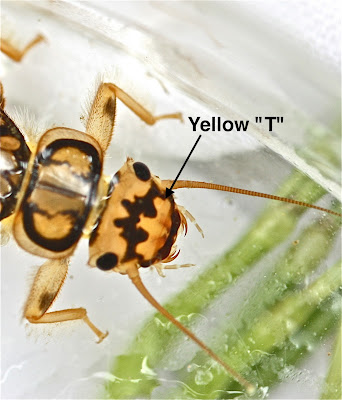I went to the Powells this morning to see what I could find. And I what I found was a whole bunch of common stoneflies (family, Perlidae). Powells Creek is an "Eccoptura stream" -- meaning "Eccoptura" is the dominant Perlid genus -- so almost every nymph that I saw (I must have seen 30-40) was Eccoptura xanthenses (there is only one species of this genus in our part of the country).
Eccoptura nymphs are semivoltine, i.e. they take two years to mature. So, the nymphs we're seeing this fall are part of next year's class -- as it were. They will graduate/hatch in May, June, and July. When they get ready to hatch, they'll look like this:
This photo was taken in the spring of this year on May 11th at the Powells. Notice how the colors and patterns change as these nymphs mature. The "dull" yellows of the immature nymphs at the top of the page have brightened considerably, especially on the abdominal bands, and some of the "browns" are virtually black. And, the wing pads on this nymph that's preparing to hatch are fully curved ("U" or "V" shaped?); those on the nymphs that I picked up this morning are only slightly rounded.
The other feature that becomes very pronounced and "clear" is the large yellow space at the front of the head that's roughly in the shape of a "T". This:
Note that it's not very clear/yellow in the young nymph on the right in the picture at the top of the page. A closer look at that nymph.
Which reminds me -- the tiny Perlid that I found at the Doyles last week (9/29), the one that I thought might be a "Beloneuria" nymph, was also (or so I now think) an Eccoptura nymph. If you look at it closely (double-click on the photo below), you can make out the "T," it's just that it hasn't enlarged and hasn't turned fully yellow.
Among the Eccoptura "crowd" crawling around in the leaf packs this morning was one lonely Acroneuria Perlid and one lonely Neoperla (the one with two ocelli on its head instead of the usual three). And, I found two mayflies -- a small minnow (Baetis intercalaris) and a flathead (Maccaffertium). The small minnow looked fairly mature, so I was anxious to get a good picture. Unfortunately, when I got around to taking my photos it was nowhere to be seen: one of the Perlids apparently ate it for lunch! (You can't let those predaceous insects out of your sight!) The flatheaded mayfly was fairly large, though still immature. Note the short tips of the wing pads.
I expect to see very small, immature large winter stoneflies any day now. And they are sure to be in the leaves.






No comments:
Post a Comment